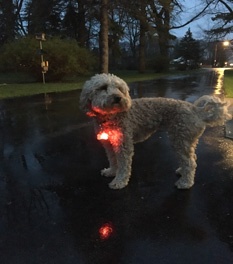 It’s official. Summer has arrived in Wisconsin. The heat and humidity are ready to meet us at the dawn of each day and like it or not, we have to get outside with our four-legged friends for some exercise and fresh-air.
It’s official. Summer has arrived in Wisconsin. The heat and humidity are ready to meet us at the dawn of each day and like it or not, we have to get outside with our four-legged friends for some exercise and fresh-air.
But what should you consider as you head outside in the heat with your pets?
As part of our Dog Days of Summer campaign with the Wisconsin Humane Society, our team of asphalt paving contractors at Wolf Paving wanted to follow up from our collar tag safety initiative with some must-know tips for pet safety during the hot summer months.
In interviews with experts from the Wisconsin Humane Society, we found some great information you need to save and share! Take a look below.
How can we help our pets cool off on a hot day?
Prevent your animal from overheating by taking walks in the early mornings and after the sun sets and consider these additional tips:
- Any outdoor exercise should be brief and in the coolest hours of the day.
- Before taking a walk, test the pavement with the palm of your hand; if it’s too hot for you to touch for an extended period of time, it’s too hot for their paws.
- Never tie an animal out in the sun; ensure they always have access to shade and plenty of water.
- Even on mild summer days, you should never leave an animal in the car; the inside can reach 160 degrees in just minutes.
Make sure you regulate the temperature inside your home on hot days, too. If your house heats up while you’re at work, leave on the air conditioning if possible; otherwise, use fans and keep your blinds closed to limit sunlight. Make sure your dog has access to a basement or the coolest room in your home.
Are there signs we should look for to know a dog is getting overheated or tired?
Symptoms of heat stroke include excessive panting, difficulty breathing, collapse, seizures, vomiting, diarrhea, confusion, rapid pulse, bright red gums, and blue tongue or lips. Young puppies, dogs who are older, overweight, have long or thick coats, or are snub-nosed (Bulldogs, Pugs, etc.) are higher-risk and should be monitored closely in the heat, along with dogs who have heart or lung diseases. If your dog exhibits any of these symptoms, you must take immediate action.

Move them to a cool place like a basement,
air conditioned room or shady area.

Provide them with cool water, but do not use ice, as rapid changes
in body temperature can cause them to go into shock.

Contact your vet immediately and be prepared to give
them a thorough and detailed list of you dogs symptoms.
What safety measures should owners use to protect their pets from biting bugs, ticks and fleas?
 Prevention is the best defense against fleas and ticks. It’s important to get your dog on routine flea and tick preventatives, but there are additional precautions you can take to keep your pet safe.
Prevention is the best defense against fleas and ticks. It’s important to get your dog on routine flea and tick preventatives, but there are additional precautions you can take to keep your pet safe.
- Make grooming a weekly habit for you and your dog — even if their coat doesn’t require it. It will keep them looking great and makes for great bonding time, but it also gives you the perfect opportunity to seek out any fleas or ticks and allows you to act quickly if you do find a parasite.
- Fleas like dark, moist, shady areas, so make sure there isn’t a lot of organic debris in your yard, such as clippings or leaf piles.
- Be sure to remove tall weeds and keep grass mowed to make your lawn less desirable to ticks.
- If you live in a wooded area or somewhere ticks are more common, make a habit of routinely checking your dog when they come inside, focusing especially around their head, neck, ears, and feet.
- Know that biting bugs are often out a dusk and protect your pet accordingly.
Are fireworks and parades safe for pets?
Just like people, some dogs enjoy public events more than others, and it’s important to respect their feelings. Forcing an animal into a situation where they’re not comfortable can be dangerous and sets them up for failure. Fireworks are confusing and terrifying for animals, so be sure to leave them at home when you head out to enjoy the show.
- Make sure they are in a quiet area of your home and have access to somewhere they’ll feel safe and sheltered, like a crate.
- Some dogs will panic when they hear fireworks and will attempt to escape, so keep all windows and doors shut so they don’t have the opportunity to leap through a screen.
- It’s also very important to keep your animal’s tags and microchip information up to date in case they do run in fear, especially if you’re celebrating at a cabin or any other non-familiar location.
Some dogs don’t mind the hustle and bustle of parades, but for most dogs, the loud music, sudden noises, and crowds of people are too overwhelming.
- If your dog is panting, pacing, frequently yawning, or whimpering, excuse yourself from the event and give them somewhere quiet to relax and de-stress.
- If your dog is comfortable in these situations, be sure to keep party-centric dangers out of their reach. Alcohol, sunscreen, insect repellent, the luminescent substance in glow sticks, and citronella are all toxic to dogs.
- Additionally, make sure your dog is always on a leash and has access to water and shade.
What should we do if our pet is afraid of fireworks, even inside the house?
Many dogs are fearful of loud sounds like thunder and fireworks, but we can take a few extra steps to make them feel more comfortable in these situations.
- Most importantly, always keep your dog indoors while fireworks are going off. A dog on leash or tied up outside can injure themselves or even break loose when trying to escape from the intimidating sounds.
- Most dogs will try to comfort themselves by hiding in a confined space; if you don’t have a crate, you can improvise by draping a blanket over a coffee table or between two chairs.
- There are many products designed to help with noise-based fears, as well. Thundershirts are cloth wraps that securely hug your dog’s body and provide a physiological calming effect.
- There are also homeopathic remedies, like HomeoPet’s TFLN, which use oils and scents to naturally reduce fear responses.
Can all dogs swim?
 Many dogs will naturally start to “doggie paddle” when they find themselves in water, but that doesn’t mean they can necessarily stay afloat or safely swim. Swimming should be a fun, voluntary task for dogs and they should never be forced into it if they’re unwilling. To test their interest, start by seeing how they react to the water in a kiddie pool. If they splash around, lay down, or continue to play in it, they’ll likely enjoy swimming. If they freeze in place or continuously jump out, respect their wishes and accept that your dog won’t be spending their summer with you in the lake.
Many dogs will naturally start to “doggie paddle” when they find themselves in water, but that doesn’t mean they can necessarily stay afloat or safely swim. Swimming should be a fun, voluntary task for dogs and they should never be forced into it if they’re unwilling. To test their interest, start by seeing how they react to the water in a kiddie pool. If they splash around, lay down, or continue to play in it, they’ll likely enjoy swimming. If they freeze in place or continuously jump out, respect their wishes and accept that your dog won’t be spending their summer with you in the lake.
When your water-loving dog is ready to graduate to deeper waters, get in with them to ensure they’re able to swim confidently for an extended period of time. If your dog loves water but isn’t a strong swimmer, consider a doggie life jacket to keep them afloat and highly visible. Whether it’s a pool, river, lake, or pond, dogs should always be monitored while swimming and their guardians should be prepared to jump in if their pet needs rescuing.
What should be considered if dogs are swimming in lakes, rivers and ponds?
If your dog loves to get in the water here are some tips you should consider for safety.
- If you have a pool at home, make sure your dog does not have access to it when you’re not around.
- Be sure that they know how to get out; teach them where the stairs are or put in a ramp if their only exit option is a ladder.
- Natural bodies of water present more dangers and require more vigilance. Keep your dog out of small, stagnant bodies of water; if the water isn’t moving and begins to heat up, it becomes a breeding ground for many dangerous bacteria.
- Once you get to a body of water, assess the area before letting your dog loose. Look on the beach and in the shallow areas for broken glass or other dangerous debris that could injure your dog’s paws.
- Be sure to check the current to ensure your dog isn’t swept away by fast-flowing water.
Lastly, always be sure to consider packing your car with the basics and the importance of a rise-down. Bring a first aid kit to allow for quick response to emergencies, fresh water for drinking, and a few clean towels. If you have access to a hose or public shower, rinse your dog off before the ride home and always dry them off as best you can to prevent skin irritation. Make sure their ears are clean and dry, too, especially if they have floppy ears or are prone to ear infections. Once you’re home, brush out your dog’s coat and check head to tail for ticks, thorns, cuts, or any potential problems.
Thanks to the team of experts at the Wisconsin Humane Society for their great insights into summer pet safety! Keep your pets safety this summer and enjoy the beautiful Wisconsin weather!
Interested in More Summer Safety Tips?
Take a look at our Summer Safety Toolkit! The Summer Roadway Safety Toolkit Includes:
- 3 Tips To Help You Brave Wisconsin Road Construction Season
- Safety First With These 10 Construction Zone Tips
- 12 Important Parking Lot Safety Tips For Pedestrians and Vehicles
- The 10 Best Driveway And Vehicle Safety Tips For Families
- 3 FREE coloring pages for kids
Download Now!
With 75 years of asphalt paving experience, from highways to driveways, we are your local source for all of your asphalt paving needs.
Wolf Paving offers professional paving services from Milwaukee to Madison, and everywhere in between, including all areas around: Sun Prairie, Oconomowoc and Waukesha.
It’s never too early or too late torequest a free paving estimate. Call Wolf Paving today. For the Milwaukee area, call us at 262-965-2121. For the Madison area, call us at 608-249-7931.
The post Pet Safety Tips for the Dog Days of Summer: Wisconsin Humane Society appeared first on http://www.wolfpaving.com/blog
No comments:
Post a Comment